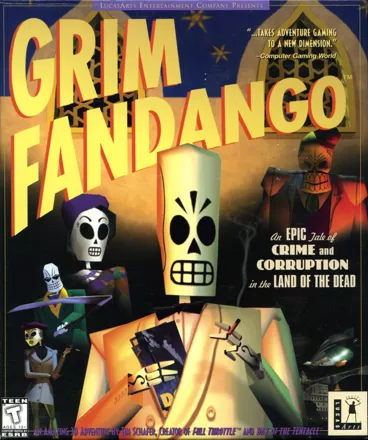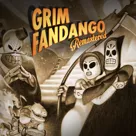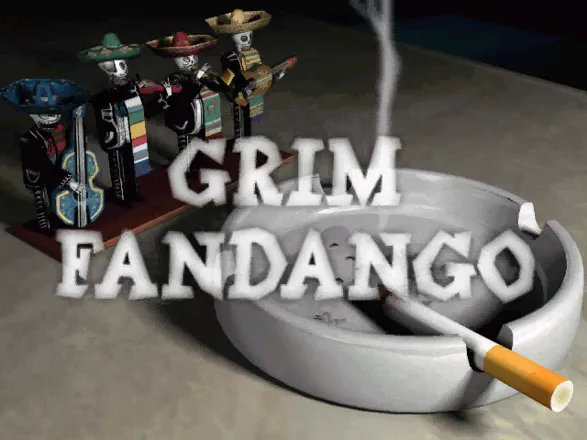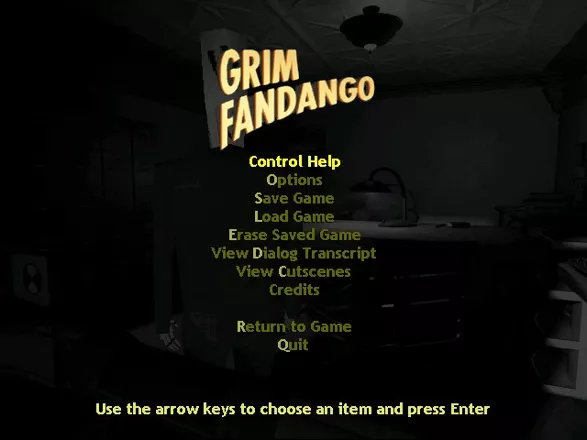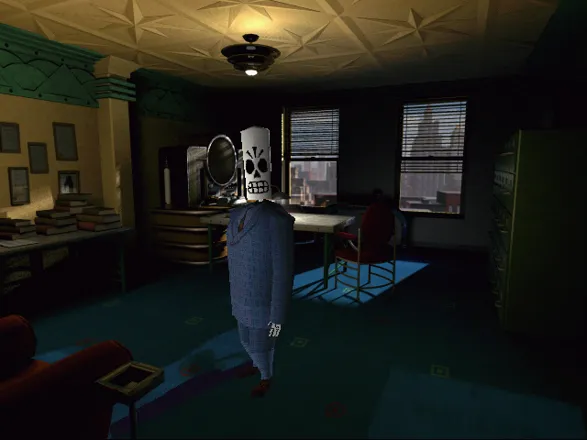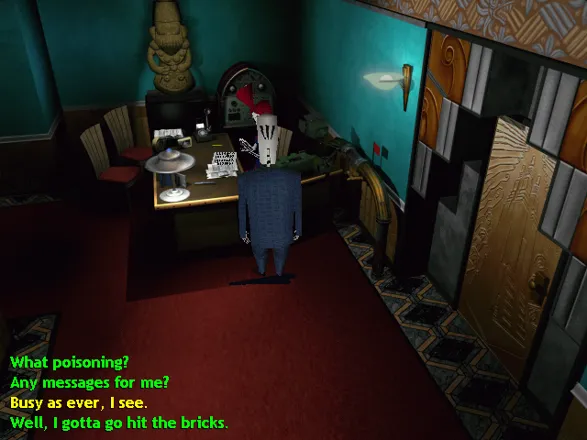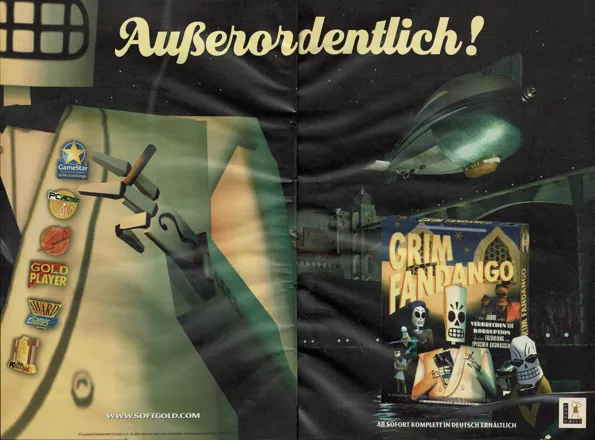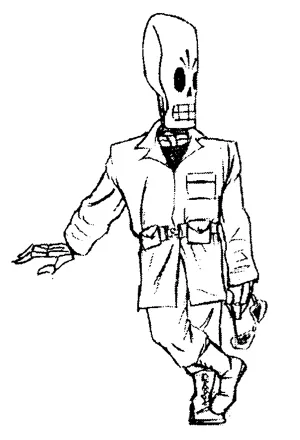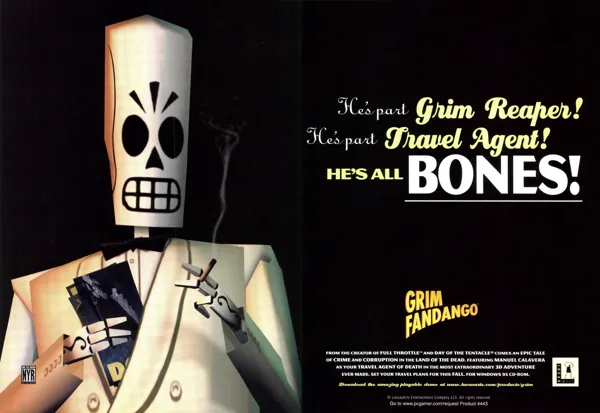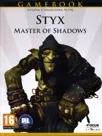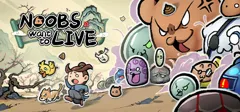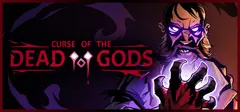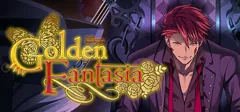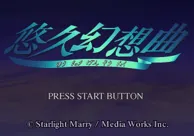Grim Fandango
Description official descriptions
Not much is known about the life of Manuel "Manny" Calavera. It is, however, known what happened to him after he died. The Land of the Dead is where all people are reincarnated after death, turning into skeletal figures. The Land of the Dead is also very similar to the world of the living: people work, have careers, fall in love, and can even die again, turning into flowers. And they all await their final destiny - a trip to the underworld. Depending on their deeds in life, they might get a good journey or be destined to walk there without any means.
Manny works in a travel agency that takes care of such trips. But recently, something has been going wrong. Manny is unable to get good clients, and he suspects that there is a scheme to falsify the dossiers of dead people, offering the best trips to scoundrels for bribes. Manny's grand adventure begins as he steps into the world of corruption and intrigues.
Grim Fandango is a puzzle-solving adventure game that describes several years of Manny Calavera's afterlife. Influenced by Mexican mythology, film noir and Art Deco, the game combines 3D characters with pre-rendered backgrounds. The traditional mouse interaction was abandoned in favor of keyboard control for movements and actions. Manny is navigated with arrow keys, and tilts his head whenever something attracts his interest; the object or character in question can then be examined or interacted with.
As usually in LucasArts' adventure games, conversations offer plenty of different responses that can be chosen by the player. Despite the lack of the option to combine items with each other within the inventory, the game still contains many challenging puzzles that require manipulating inventory items and the environment.
Spellings
- 冥界狂想曲 - Simplified Chinese spelling
- 神通鬼大 - Traditional Chinese spelling
Groups +
Screenshots
Promos
Videos
Add Trailer or Gameplay Video +1 point
See any errors or missing info for this game?
You can submit a correction, contribute trivia, add to a game group, add a related site or alternate title.
Credits (Windows version)
188 People (187 developers, 1 thanks) · View all
| Project Leader | |
| Lead Artist | |
| Lead Programmer | |
| Conceptual Artist | |
| Music Composed and Produced By | |
| Assistant Designers | |
| Production Manager | |
| Production Coordinator | |
| Programmers | |
| Character Animation | |
| Background Artists | |
| [ full credits ] | |
Reviews
Critics
Average score: 92% (based on 55 ratings)
Players
Average score: 4.2 out of 5 (based on 412 ratings with 23 reviews)
A great game with some minor flaws
The Good
Graphically this game was quite cutting edge at the time. I just finished it in 2004, quite some time after it's 1998 release, yet it didn't seem particularly dated. This is a commendable achievement that few games can claim. Part of what makes the graphics remain fresh to this day is the creative and interesting scenes you find yourself in throughout the game. There is a consistent neo-aztec feel to the architecture which is quite cool and has yet to be recreated to such an extent. Additionally, there is a consistent lack of repetition in the environments that modern games could learn alot from. The character models are varied and full of character. It's amazing to me how much personality the designers put on a skeleton's face.
The sound in the game is quite nice as well. The music fits the various environments quite well, the sound effects are great, and the voice acting is superb throughout. Some of the best voice acting I've heard in a game actually. The conversations are crass and entertaining. The sound helps immerse you which is necessary for third-person adventure games. The sounds all suit the events that they are matched too, which is another thing modern games could learn from.
The gameplay is pretty good for the most part, though see below for some complaints. Character control is through the keyboard, as was common in that day and age. It is, of course, and adventure game, which means the challenge in the game is figuring out what it is you're supposed to do. I must admit I'm crap at adventure games and I always need a walkthrough of some kind, but even with this handicap, I found that the tasks you're supposed to engage in are logical about 50% of the time. It IS difficult at times to see what items you're supposed to manipulate. If there is any weakness to this game, it's in the gameplay.
The story is superb. I found myself enjoying the main character immediately, which is yet ANOTHER thing modern games could learn from. It's a compelling story, the characters are quite humorous, and above all, it's an enjoyable story. Sometimes the conversations lead to confusion about what one is supposed to do, but at all times your 'main' goal is clear. I play adventure games for the plot alone, and I was quite impressed by this one. It's not an epic-hero story, unlike most RPG's and some action games, which is a nice change. It's a fun, engaging detective story that I think everyone can enjoy.
The Bad
The only weakness in this game is in the gameplay. A good 50% of the puzzle solutions are absolutely obscure. The decision of which inventory item to use where and when is quite frequently illogical in my opinion. This could be because I haven't the knack for adventure games, I grant that, however, I think there is a latent difficulty to this game that isn't due to my lack of cognitive capacity. This flaw is made worse by the difficulty in finding all of the necessary items to solve problems. This gets annoying quite quickly, but there are a myriad of walkthroughs available on the internet, as a simple google search will show. So while this flaw is noticeable, it's not a major problem to playing the game.
The Bottom Line
I would recommend it to anyone. It can be found for practically free from game vendors. It's got a wonderful plot and the characters are great. It's almost a perfect example of how good a game can be. I was even more impressed for the fact that i'm not usually an adventure gamer. This is a 'must-play.'
Windows · by Marty Bonus (39) · 2004
The Good
LucasArts brought joy and excitement to adventure fans during their most dominant era - the early 1990's. However, like many other genres, adventure games underwent a crisis during the troublesome second half of the decade; unlike some other genres, they never truly recovered. I think that LucasArts' own output during that time was inferior to what they have achieved before. That is, with the exception of one game, where the company's creativity suddenly broke out with unseen power - only to be silenced for good afterwards.
Grim Fandango can be described in three words: hardcore classical adventure. Which means that it does not follow the fashionable route of Myst, nor does it dumb down gameplay in favor of long cutscenes and whatever else the dramatization of the genre has brought with it. This game has puzzles, and many of them are tough - but, with a few exceptions, they aren't abstract; they are organically woven into the game's texture, inseparable from its world. It is not one of those games that throws thousands of puzzles at you without giving you any clues - no, the clues are there, yet due to their sheer complexity, the puzzles are often difficult to solve. Being a very large game, it also demands a lot of concentration from the player.
Grim Fandango follows the classic LucasArts rule (no dying, no getting stuck), and the amount of experimenting with items is somewhat reduced by the inability to combine items within your inventory - but do not think for a second that this makes the game any easier. Typical inventory-based puzzles are relatively rare compared to complex machinery-oriented tasks you'll encounter in many parts of the game. But the strength of its puzzle design lies in the fact that those puzzles are neither isolated nor self-sufficient. There is still plenty of fun item-collecting from the good old comedy days, and rich dialogue branches to explore. In short, there is variety and challenge - two essential components of good game design.
Grim Fandango is a large game - both in terms of longevity and the size of its world. The developers struck a perfect balance between free-form exploration and focused advancement, giving us generous playable areas that take a while to complete, but also changing the scenery drastically in each of its several long chapters. Thus, the game avoids both the radical streamlining of Full Throttle and the monotonous hub-exploration of The Dig. The sheer magnitude of its world reminded me of Zak McKracken - of all LucasArts adventures, these two are the only ones I would describe as "epic".
The game's world is a stylish masterpiece possibly surpassing everything the company has done before in pure artistic value. I have never seen its main stylistic components united in the same work - let alone in such a seamless and convincing fashion. Whoever first came up with the bizarre idea of mixing film noir with Art Deco and Mexican mythology deserves a special prize in a competition for original settings. Even a weaker game would be worth checking out just thanks to the unique world.
This world has been carefully crafted in meticulous detail, turning simple office rooms into chef-d'oeuvres of visual design. Colors, angles, decorations, architecture, furniture, character faces, street lamps - everything is recreated with almost decadent opulence, brilliantly reflecting the main themes of the game's story. The pre-rendered backgrounds are splendidly rich and colorful, and well-animated 3D character models are combined with them immaculately. In general, Grim Fandango is one of the most lavishly presented adventure games of all times.
Grim Fandango also has one of the best stories ever to grace an adventure game. In a world where this genre has been firmly associated either with lighthearted comedy or the enigmatic vagueness of Myst-like impressionist style, Grim Fandango rises with its gripping plot full of intrigues, corruption, romance, and much more. It is world-embracing, intimate, touching, complex, and emotional. The most remarkable aspect of this story is that it depicts several years of the hero's life (or, in this case, life after death). While most games usually describe only a short episode they consider noteworthy, Grim Fandango draws all the right conclusions from its structure and weaves an epic tale with all its heights and lows, showing how time changes people and things, and how easy it is for us to gain or lose everything we have.
There are plenty of locations in the game, and most of them are original and memorable - the port city Rubacava with its casinos, luxury hotels, mafia bosses, and tattoo parlors, the depths of the sea, the mountains, etc. All those locations are extremely detailed and filled with people and objects, so that a strange melancholic and even nostalgic feeling envelops the player - it is just like real life, yet the real life is so far away. Yet at the same time the game is endearingly humorous. It liberally pays homage to film noir, crime novels, and other literary and cinematic styles with a dedicated realism that intensifies the dark comic effect: the supposedly desolate, mysterious afterlife turns out to resemble our world in everything - particularly in sin. Who could help smiling watching the scene where Meche removes her stockings in a perfectly captured "femme fatale" style?..
Grim Fandango is full of characters, and most of them are singularly memorable. The protagonist himself truly grows as a person - initially not particularly reliable, even a bit of a crook, Manny is gradually revealed as a courageous person, able to love deeply and without compromises. The lovable demon Glotis provides mild comic relief, but he is also a great friend with a magnanimous soul - a seemingly excellent pianist as well. I have rarely seen an adventure game with so many characters, each occupying a relatively important spot in the rich tapestry of the story.
The Bad
I wasn't as offended by the interface as some other fans of point-and-click adventures, but I can't say I liked it. You can only interact with an object if you physically approach it, at which point Manny will tilt his head in the general direction. This means you'll have to run around a lot in a busy environment, which doesn't fit the pace of adventure gameplay. Camera angles change frequently, and keyboard-based character navigation is uncomfortable no matter whether you choose the camera- or the character-dependent control scheme. I don't quite see why it was impossible to use the mouse for movement and cursor-based interaction.
Grim Fandango is highly creative, and yet there was a tiny something in the gameplay where symptoms of crisis in adventure game design could be felt. I welcomed the high difficulty level, but a few puzzles were tricky in an illogical and somewhat contrived sense - I felt that there was rather too much precision required to solve them. Then again, it is infinitely preferable to simplifying the gameplay, and luckily for the most part they balanced the puzzle difficulty remarkably well.
The Bottom Line
It was a long way from Maniac Mansion to Grim Fandango, a glorious road decorated by quite a few masterpieces. Born within a crisis that has befallen its creators and the adventure genre in general, Grim Fandango is one of LucasArts' best offerings. It is the most mature and complete manifestation of their design philosophy and a fitting epitaph to their work, a powerful final chord crowning their beautiful symphony.
Windows · by Unicorn Lynx (181775) · 2014
Ultra stylish epic, and the beauty is more than skin-deep.
The Good
Pretty much the whole thing. Superb presentation backed up with some of the best graphics in an adventure game to date. Glorious cut-scenes with beautiful sweeping camera angles, giving the game a more cinematic and film-like quality than any other game I've ever seen. Terrific characterization, to the extent where you can tell the rudimentary personality of some of the characters after about 2 lines of dialogue.
The puzzles are rock-hard! Just the way they should be. Many require deep lateral thinking as well, especially later in the game. There are many deep and varied locations to visit, including the fantastic gambling port-side town Rubacava, and on the bottom of the sea bed. Our hero, Manuel Calavera, oozes charisma and charm making him a joy to control. The atmosphere is believable and immersive.
Oh, and it also has the world's best soundtrack. It is Lucasarts and everything, so you can expect this to some degree. But it blends forms of Jazz with Mexican folk music in a seamless way as if the two were born to go with each other. This leads nicely onto the art work and whole theme of the game which once again, blends film noir with Mexican folklore with art-deco. If you want any proof of the incredible attention to detail and professional quality of it all, look in the inside of the CD case.
The Bad
If you're a novice when it comes to adventure games then this will take you some time. Admittingly, some of the puzzles are a bit dodgy and unrealistic. For example, the one on the roof of the Department Of Death building in the first quarter of the game. You may find the game boring as well, like someone I know. In which case see a psychiatrist.
The Bottom Line
This is how adventure games should be done. Proof that money equals results. Not to mention it's by that virtuoso games designer Tim Schafer. This one drips class. Go buy.
Windows · by Shazbut (163) · 2002
Trivia
1001 Video Games
Grim Fandango appears in the book 1001 Video Games You Must Play Before You Die by General Editor Tony Mott.
Cut dialogue
Originally, Manny could find out the entire conspiracy in a conversation with Domino in Year Three. The audio files shipped with the game, but the dialogue tree was cut.
Gags
- In the hallway of the DOD there is a picture of a boat. If you look at in Manny says "Not that I have a choice, but I wonder if I would be happier working on a ship. Then again I'm so competitive I wouldn't be able to rest until I was Captain." At the end of year two on the ship he is just the cleaner, and then a year later he is the captain.
- The main character in this game is a skeleton, take a look at the side of the box and you'll see a different LucasArts logo. The usual golden figure who raises his arms (towards the sun?) is replaced by a skeleton.
References
- The game's hero is Manny Calavera. Calaveras are actually those skeleton-dolls, which the majority of the characters in this game are.
- One of the characters is called Olivia Ofrenda. "Ofrenda" is a Mexican celebration of the dead.
- As in many others LucasArts games, you can find Max, from Sam & Max. Go to the tattoo parlor (in Rubacava, you must walk all the way to the right). Take a look to the poster and you will find him in the tattoo designs.
- In year 2, there is a part of the game where you see a Blimp/Zeppelin hovering in the air above the Cat Tracks... As you cross the bridge under it, a short melody plays which is part of the opening theme to Secret Weapons of the Luftwaffe... and older World War 2 flightsim from Lucasarts (or Lucasfilm Games as it was known back then)
- Including the references mentioned below, the game's characters have many similarities to actual Day of the Dead objects. There is, for example, Don Copal - Copal is a festive resin from tropical trees often burned in special bowls on graves during the Day of the Dead in Mexico.
- You soon end up working for an underground organisation called the L.S.A., or the Lost Souls Alliance. As stated in the manual Grim Fandango is steeped in references to Aztec and Mayan culture and art (as well as Mexican folklore and film noir of the 1930's, 40's and 50's). LSA (for short) is the psychoactive ingredient of 'Ololiuqui' - the Aztec name for the seeds of certain plants that have been used and held sacred by the Aztecs for many years. This may or may not be intentional but trivia nonetheless!
- The game contains a reference to Frank Herbert's sci-fi cult novel Dune. At the end of the 4th year, when Salvador bites down on a fake tooth, releasing a cloud of poison that kills both him and his victim, he alludes to an almost identical event in Dune.
Budget & Sales
The budget was a whopping 3 million dollars but the sales didn't live up to that investment. As of 2004, Grim Fandango is the only game that didn't make LucasArts a profit.
Saving screen
As you progress through the game, more of the design over the save screen will show.
Title
The game was originally going to be named Deeds of the Dead but the management at LucasArts didn't want a reference to death in the title.
Awards
- Computer Gaming World
- April 1999 (Issue #177) – Best Adventure Game of the Year (together with Sanitarium)
- January 2001 (Issue #199) – Introduced into the Hall of Fame
- March 2001 (Issue #200) - #7 Best Game Of All Time
- GameStar (Germany)
- Issue 12/1999 - #87 in the "100 Most Important PC Games of the Nineties" ranking
- PC Gamer
- April 2000 - #41 in the "All-Time Top 50 Games" poll
- PC Player (Germany)
- Issue 01/2000 - Best Adventure in 1999
- PC Powerplay (Germany)
- Issue 11/2005 - #2 Game Which Absolutely Needs A Sequel
- Power Play
- Issue 02/1999 – Best Adventure in 1998
Information also contributed by Adam Baratz, Emepol, James Isaac. PCGamer77, Roedie, Scott Monster, [SDfish, [Tom Murphy](http://www.mobygames.com/user/sheet/userSheetId,66915/), [WildKard](http://www.mobygames.com/user/sheet/userSheetId,16566/), [Unicorn Lynx](http://www.mobygames.com/user/sheet/userSheetId,6226/) and [Zack Green](http://www.mobygames.com/user/sheet/userSheetId,9727/)](http://www.mobygames.com/user/sheet/userSheetId,45163/)
Analytics
Upgrade to MobyPro to view research rankings!
Related Sites +
-
3DGamers
Location for downloading the Grim Fandango Demo and Patch -
Department of Death
A huge Grim Fandango fan site, with screenshots, movies, fan fiction and much more! -
Gamespot's Grim Fandango Game Guide
a good walkthru for the game -
Grim Fandango - FAQs & Guides
Many different walkthroughs and guides on GameFaqs.com -
Grim Fandango Network
A fan site. -
Hints for Grim Fandango
Stuck? These hints will help you solve the game. -
ResidualVM
A cross-platform, open-source interpreter capable of making Grim Fandango run on a number of modern operating systems. -
The D.O.D. Travellers' Guide
A site with a drawn out map of the "Land of the Dead", with information about all of the locations.
Identifiers +
Contribute
Are you familiar with this game? Help document and preserve this entry in video game history! If your contribution is approved, you will earn points and be credited as a contributor.
Contributors to this Entry
Game added by Ryan Lucas.
Additional contributors: Swordmaster, Xa4, Unicorn Lynx, Jeanne, Zack Green, Shoddyan, James Isaac, Zeppin, CaesarZX, Paulus18950, Cantillon, Thomas Helsing, Patrick Bregger, Ingsoc, FatherJack.
Game added August 10, 1999. Last modified March 27, 2024.
